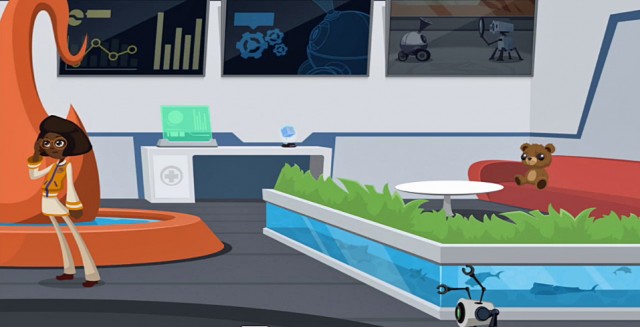Part 13 of MindShift’s Guide to Games and Learning.

In education, it seems as if innovation and revolution play like the song of the Sirens in a culture of perpetual obsolescence. It seems as if we’ve got an unhealthy fetish for new-ness, indiscriminately choosing the convenient disposability of shrink-wrap over the sustainability of the well-worn.
Digital games can be amazing tools, but only when used to make it easier to contextualize the gifts we’ve received from Shakespeare, Socrates, Euclid, and others. The thing about tools is that their strength is usually derived from the way they approach a problem rather than in the particularity of the solution they offer. For example, consider the hammer: a great technological innovation that our human ancestors imagined more than 2 million years ago. What made it revolutionary was not so much in the material from which it was assembled, nor the particular object it bashed. Instead, the hammer was revolutionary because it forever transformed human experience by introducing the possibility of striking, and therefore altering, our natural surroundings. It changed the way we look at things.
Still today, a great deal of our teaching is essentially grounded in teaching the perspective that early tools enabled. We want our students to know that humans have the capacity to shape their own world. We want them to provide them with the skills necessary to do so. We want to teach them how to utilize the ways of knowing that were made possible through the technological innovations that enabled, produced, and shaped the civilizations of the past and the present.
Our current civilization is built on information technologies. Smartphones, the internet, and video games are all simply hunks of machinery that become special because they introduce new interactive narrative structures. They introduce non-linear ways of thinking about the world and organizing information.
When we look at a network, or a jumble of hyperlinks, or an interactive simulation like a video game, it immediately appears chaotic. This is because we are conditioned to make sense of it using the habitual linear narrative traditions that have defined “literacy” for a few thousand years. We try to identify beginnings, middles, and ends. But new narrative conventions require a different form of literacy: systems literacy.
Systems literacy is playful and inter-subjective. It defines order according to the way things interact with one another. It privileges the quality of the relationship between nodes rather than trying to figure out what is first, last, and in-between (value judgments). Systems work more like a sandboxes than ambitious ladders to the top.
In the current world, our schools should be focused on teaching both linear and non-linear ways of knowing. We need to remember that the goal of technology is ultimately to help us mentor our youth so that they become familiar with the many ways of knowing that humanity has discovered. It’s not just to develop proficiency with today’s tools while maintaining yesterday’s predominant thinking.
This shift is precisely what seems to be happening at the Quest to Learn School. Curriculum experts and game designers work together to reimagine what school might look like if it drew its inspiration from video games. The New York City public school employs a standards-based integrated curriculum that “mimics the action and design principles of games by generating a compelling ‘need to know’ in the classroom,” as they describe it. The goal: to intrinsically motivate kids toward mastery. Students seek out knowledge because they need to know it in order to complete a project based task.
Quest to Learn doesn’t set out to change the learning objectives, but rather the process through which they are achieved. Of course, process and product are indistinct. Transform the shape of the container and you simultaneously alter the the kind of content that can fit inside. Sometimes you don’t notice all the implications just by looking at the surface. Students at the Quest to Learn School “encounter a series of increasingly complex, narrative challenges, games or quests, where learning, knowledge sharing, feedback, reflection and next steps emerge as a natural function of play.”
GAMES IN PRACTICE
When I visited Quest to Learn, I saw a school that looked very similar to any other school, except every student seemed engaged, empowered, and motivated. It wasn’t what I expected from a place that most people describe as “the video game school.” There weren’t screens all over the place. No fingers pounding game controllers. I didn’t see tons of gadgets or gizmos. But I did see a curriculum that was designed to approach from a video game perspective. The organizational structure through which material was presented was game-like.

“Failure is reframed as iteration” reads one poster that’s hanging by the elevators. Another explains how to break down complex ideas: “Systems are all around us — games are playful systems.” Students are encouraged to analyze, interpret, and articulate using categories like space, components, rules, challenges, core mechanics, and goals. They apply this model, or other game-based systems-thinking models, to almost everything.
In one class, kids play Socratic Smackdown. Eighth-grade English Language Arts Teacher/Designer Rebecca Grodner created the game to teach the building blocks of argumentation while simultaneously making a space where students practice and assess their peers’ conversational etiquette. Students might earn points for using supporting evidence or playing devil’s advocate. They lose points for interrupting or insulting other players. They’re intrinsically motivated to learn the components of rhetoric, to understand how they function within a discursive system, and to be able to use them in everyday contexts.
In another class, the students play Rock-onimoes, a geology-themed version of dominoes that asks players to make connections by using words like sedimentary and magma. Again, they need to understand the relationships between the geological concepts. Success is a product of their to ability use complex concepts in context, not to memorize and regurgitate.
Quest to Learn shows us what happens when the old “factory model” of organization is replaced with a systems-based game-like paradigm. They call it games, systems, or design. That’s code for understanding content in context — and for seeing the interconnectedness between elements.
“We need to do a better job at giving children and young people opportunities to rise, which means developing systems that enable that rise — that enable them to move across networks and to engage in really hard problems with relevant resources. Games are all about creating spaces of possibility, where players feel they can do anything,” writes Katie Salen, who helped launch and design Quest to Learn while she was the founding executive director of the Institute of Play.
Systems are all about connections, networks, and the ways in which nodes relate to one another. This focus on connections might also be one of the building blocks of citizenry, humanity, and social community. Perhaps this is why one of Quest to Learn’s core values is “Collaboration Matters.” You can see it manifest among their students. They embody it. They know that “we need the support, ideas, and respect of others to truly succeed.”
The MindShift Guide to Games and Learning is made possible through the generous support of the Joan Ganz Cooney Center and is a project of the Games and Learning Publishing Council.




